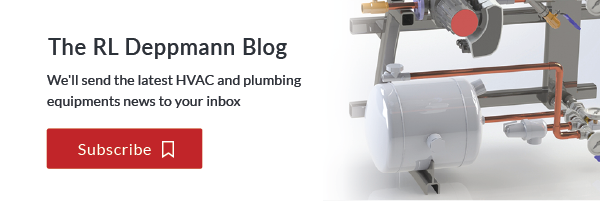We could entitle the next dozen weeks as: TANKS-A-LOT. (Sorry). Over the next few months, the Monday Morning Minutes blog will examine expansion and compression tank sizing. We will also tackle some more advanced issues in the selection and troubleshooting of closed system expansion tanks.
Tanks are often selected using software programs such as the Bell and Gossett ESP-Plus™ selection program. It is always valuable to understand what is going on behind the program so let’s start with the formula behind the program and some basic terms.

Vt = The minimum tank volume in gallons
Ef – Ep = The expansion of the fluid minus the expansion of the pipe
Vs = The system volume in gallons
Pa = The initial pressure in the tank before any fluid is introduced (Absolute PSIA)
Pf= The cold fill pressure in the tank before heating or cooling (Absolute PSIA)
Po = The final or maximum pressure your design requires in the tank after heating (Absolute PSIA)
The numerator of the formula, (Ef – Ep) X Vs is called the Tank Acceptance Volume. Back when the original gravity flow hydronic systems were designed, there was an open expansion tank normally located in the attic. As the boiler fired, the water would expand and the level in the tank would rise. The starting pressure was atmospheric and so was the ending pressure since the tank was open. So the tank volume equaled the acceptance volume.

Today it is rare to use an open expansion tank. Today we use compression or expansion tanks. The terms are sometimes used interchangeably but in theory a compression tank is a closed tank with no physical separation between the fluid and the air in the tank. As the fluid volume increases, the air in the tank is compressed. An expansion tank, in today’s world, is a closed tank with a membrane or physical separation in the tank. The tank starts with no fluid in the tank and the fluid expands into the tank as the fluid volume increases.
See the rest of this series:
- Expansion and Compression Tanks Formulas – Part 2
- Acceptance Volume of Expansion and Compression Tanks – Part 3
- Cold Fill Pressure – Expansion and Compression Tanks – Part 4

Disclaimer: R. L. Deppmann and it’s affiliates can not be held liable for issues caused by use of the information on this page. While the information comes from many years of experience and can be a valuable tool, it may not take into account special circumstances in your system and we therefore can not take responsibility for actions that result from this information. Please feel free to contact us if you do have any questions.
